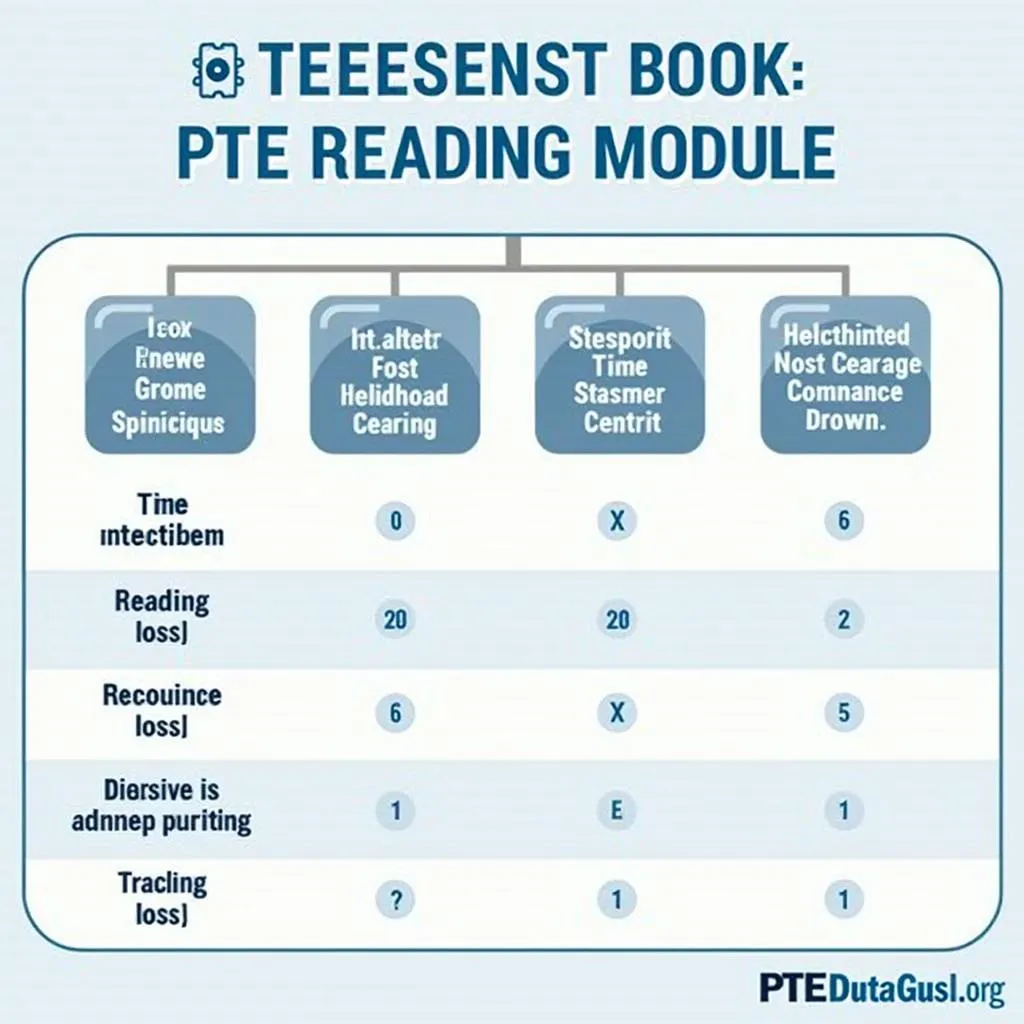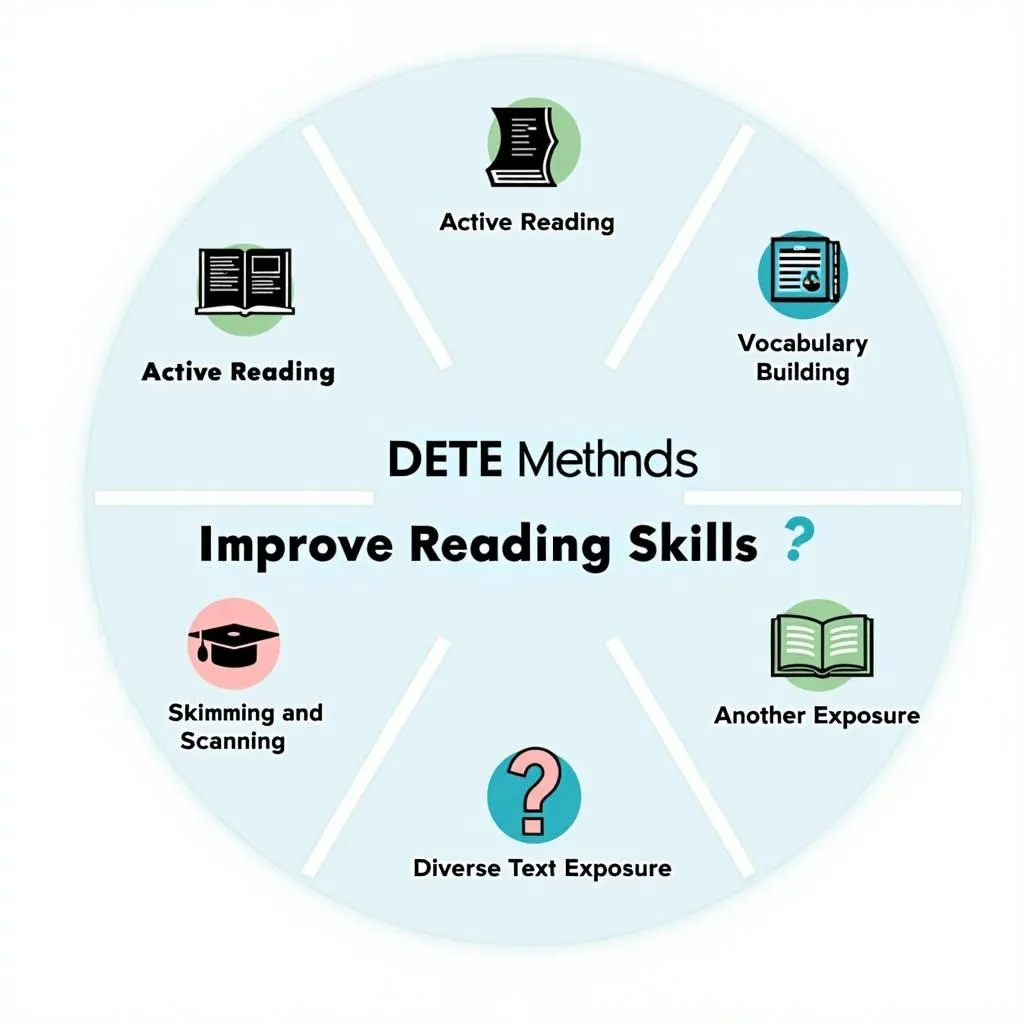The PTE Reading module is a crucial component of the Pearson Test of English Academic. To excel in this section, it’s essential to understand the official tips and strategies provided by PTE experts. This comprehensive guide will walk you through the most effective techniques to tackle the reading tasks and boost your score.
Understanding the PTE Reading Module Structure
Before diving into the tips, let’s briefly overview the reading module’s structure. The PTE reading section typically includes:
- Multiple-choice questions
- Re-order paragraphs
- Fill in the blanks
- Reading & writing: Fill in the blanks
Each task type requires a specific approach, which we’ll explore in detail.
 PTE Reading Module Structure Overview
PTE Reading Module Structure Overview
Official Tips for Multiple-Choice Questions
Multiple-choice questions test your ability to comprehend written texts and select the most appropriate answer. Here are some official tips to tackle this task:
- Read the question carefully before looking at the text
- Scan the text quickly to locate relevant information
- Eliminate obviously incorrect options
- Look for synonyms and paraphrases of the question in the text
- Double-check your answer against the text
Remember, time management is crucial. Don’t spend too long on any single question.
Strategies for Re-order Paragraphs
The re-order paragraphs task assesses your ability to organize text in a logical and coherent manner. Follow these official tips:
- Identify the topic sentence, which often introduces the main idea
- Look for connecting words and phrases that link paragraphs
- Pay attention to pronouns and their references
- Consider the logical flow of ideas from general to specific
- Read the reordered text as a whole to ensure it makes sense
Practice this task regularly to improve your performance. You can find PTE reading module practice tips to enhance your skills further.
Mastering Fill in the Blanks
Fill in the blanks tasks come in two varieties: with and without a word bank. Here are the official tips for both:
With a Word Bank:
- Read the entire text first to understand the context
- Look at the given words and their parts of speech
- Consider collocations and common phrases
- Use the process of elimination
- Check grammar and sentence structure
Without a Word Bank:
- Read the surrounding context carefully
- Consider the grammatical form required (e.g., noun, verb, adjective)
- Think about common collocations and idiomatic expressions
- Use your knowledge of academic vocabulary
- Proofread your answers for spelling and agreement
 PTE Fill in the Blanks Strategies
PTE Fill in the Blanks Strategies
Reading & Writing: Fill in the Blanks
This task type combines reading comprehension with vocabulary and grammar skills. Official tips include:
- Read the entire passage to understand the overall meaning
- Pay attention to the words before and after the blank
- Consider the grammatical structure of the sentence
- Look for clues in the broader context of the paragraph
- Choose words that fit both semantically and grammatically
Dr. Emma Thompson, a renowned PTE expert, advises, “The key to success in the reading & writing fill in the blanks task is to approach it holistically. Consider not just the immediate context, but how each word contributes to the overall meaning of the passage.”
Time Management in the PTE Reading Module
Effective time management is crucial for success in the PTE reading module. Here’s how to allocate your time wisely:
- Familiarize yourself with the time limits for each task type
- Practice with timed mock tests regularly
- Develop a personal pacing strategy
- Don’t spend too much time on any single question
- Leave time to review your answers if possible
To improve your time management skills, consider how to use mock tests effectively for PTE.
Enhancing Your Reading Skills
To excel in the PTE reading module, it’s essential to continuously improve your overall reading skills:
- Read a variety of academic texts regularly
- Practice active reading techniques
- Build your academic vocabulary
- Work on your skimming and scanning abilities
- Engage with complex texts on unfamiliar topics
Professor David Chen, a PTE preparation specialist, states, “Consistent exposure to diverse academic texts is the foundation of success in the PTE reading module. It’s not just about test techniques; it’s about developing genuine reading proficiency.”
 PTE Reading Skills Enhancement Techniques
PTE Reading Skills Enhancement Techniques
Utilizing Official PTE Resources
Take advantage of official PTE resources to maximize your preparation:
- Official PTE practice materials
- PTE Academic official app usage
- Scored practice tests
- PTE skill-building exercises
- Official PTE webinars and tutorials
These resources provide authentic practice and insights directly from the test creators.
Conclusion
Mastering the PTE reading module requires a combination of strategic approach, consistent practice, and skill development. By following these official PTE reading module tips and incorporating them into your study routine, you’ll be well-equipped to tackle the challenges of the test and achieve your desired score. Remember, success in the PTE reading module is not just about test-taking strategies; it’s about becoming a proficient reader in academic English.
FAQ
How long is the PTE reading module?
The PTE reading module typically lasts between 32-41 minutes, depending on the specific combination of tasks in your test.
Can I go back to previous questions in the PTE reading module?
No, the PTE reading module is a computer-based test where you cannot return to previous questions once you’ve moved on.
How is the PTE reading module scored?
The PTE reading module is scored using advanced statistical and mathematical models, considering factors like difficulty and skill level for each item.
Are there any penalties for wrong answers in the PTE reading module?
There are no penalties for wrong answers in the PTE reading module. It’s always better to attempt every question.
How can I improve my speed in the PTE reading module?
To improve your speed, practice regularly with timed mock tests, work on your skimming and scanning skills, and build your academic vocabulary.
Is the PTE reading module easier or harder than IELTS?
The difficulty level can be subjective. Some find PTE easier due to its computer-based format, while others prefer IELTS. It’s best to try practice tests for both to see which suits you better.
How often should I practice for the PTE reading module?
Consistent practice is key. Aim to dedicate at least 30-60 minutes daily to reading practice, focusing on a variety of PTE-style tasks and academic texts.